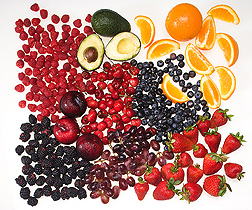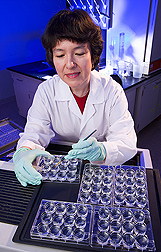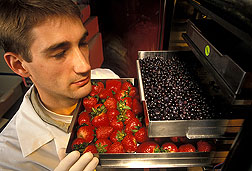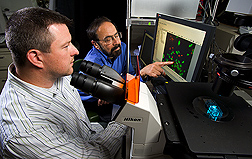First in a Series:
Nutrition and Brain Function
Food for the Aging Mind
Scientists know that certain nutrients and other key chemical compounds are essential to human brain function. Serious deficiencies in some of these, such as vitamin B12 and iron, can lead to impaired cognitive function due to neurological, or nerve fiber, complications.
Cognition can be defined as the ability to use simple-to-complex information to meet the challenges of daily living.
So, could careful attention to diet help protect the aging brain from problems with nerve cell signals involved in memory and cognition? A clear-cut answer could greatly affect the 77 million baby boomers who are now facing retirement. Their independence, quality of life, and even economic status will largely be defined by their ability to traffic information signals as they age.
In researching the nutrition-brain connection, new technologies are being used, such as those that take images of the brain or actually count individual brain cells. Behavioral tests that measure motor and cognitive skills—or lack thereof—are also providing insights. Yet the science of nutrition and brain function is relatively new and evolving.
Agricultural Research Service scientists at several locations nationwide are contributing to a growing body of research that explores the effect of diet and nutrition on the brain and its function across the lifespan.
|
|
Boosting Neuronal Function
The brain’s billions of neurons “talk” to one another through chemical neurotransmitters that convey signals through neural pathways. These chemical transporters—which include norepinephrine, serotonin, and dopamine—are key to signal movement.
Although people naturally lose brain cells throughout their lives, the process of neuronal death does not necessarily accelerate with aging. “There is a lot of individual difference,” says ARS neuroscientist James Joseph. “Loss of mental agility may be less due to loss of brain cells than to the cells’ failure to communicate effectively.”
Joseph heads the Neuroscience Laboratory at the Jean Mayer USDA Human Nutrition Research Center on Aging (HNRCA) at Tufts University in Boston. There, researchers are looking at the beneficial effects of certain dietary plant compounds to learn how they affect brain function.
“Vitamins and minerals in plant foods provide protective antioxidants,” says Joseph. “But fruits, vegetables, nuts, seeds, and grains contain thousands of other types of compounds that contribute significantly to the overall dietary intake of antioxidants.
“A partial measure of the antioxidant effect is called ‘ORAC,’ for Oxygen Radical Absorbance Capacity. ORAC scores are now showing up in charts and on some food and beverage packages. They may be helpful in choosing foods to include in your diet.”
Perhaps there is no better place in which to gauge the power of antioxidants than between the minute connections of the nerve cells.
|
|
Bucking Long-Held Dogma
Eight years ago, Joseph and colleagues began publishing a series of studies, done in rodents, that shed light on the relationship between various diets and the mechanisms behind cognitive losses in specific neighborhoods of the aging brain.
Many in the series are groundbreaking in that they challenge the long-accepted belief that the central nervous system, which includes the brain, is not capable of regenerating itself. Other published studies in the series echo similar findings based on primate and human brain research at the Salk Institute for Biological Studies, San Diego, California. Scientists there, using new technologies, disputed the notion that the brain does not make new neurons—a process called “neurogenesis”—into old age: It does, but at a much slower rate.
One of the first of Joseph’s studies, published in the Journal of Neuroscience, showed a protective effect of consuming antioxidants. Study rats were fed—from adulthood to middle age—vitamin E, strawberry extracts, or spinach extracts, all with similar ORAC values. Animals receiving the high-antioxidant diets did not experience the age-related cognitive performance losses seen in control rats fed standard chow.
|
|
A later study, also published in the Journal of Neuroscience, showed a reversal of functional loss among rats on special diets. Each of three groups of rats, equivalent in age to 63-year-old humans, was fed a different high-antioxidant extract. A control group was fed standard chow. After 8 weeks—equivalent to about 10 years in humans—the rats’ performance levels were measured.
The rats fed the spinach, strawberry, or blueberry extracts effectively reversed age-related deficits in neuronal and cognitive function. In addition, the blueberry-fed group far outperformed their peers while traversing a rotating rod to test balance and coordination.
“Despite their status as ‘senior citizens,’ those rats showed remarkable stamina on neuromotor function tests,” says psychologist and coauthor Barbara Shukitt-Hale, also with the Neuroscience Laboratory.
Examination of the brain tissue of those blueberry-fed rats showed much higher levels of dopamine than were found in the other groups. Dopamine has many functions within the brain. In particular, it can affect the way the brain controls movements.
“We suspected that the combined antioxidant potency of compounds in blueberry extract may have reduced inflammatory compounds in the brains of these older animals,” says Joseph. “Inflammation ordinarily contributes to neuronal and behavioral shortfalls during aging.”
Tests have since shown that blueberry compounds cross the blood-brain barrier and localize in rodent brain tissue.
Hard News: Brain Plaques
Later, the lab’s researchers published an Alzheimer’s disease model study in Nutritional Neuroscience. They studied mice that carried a genetic mutation for promoting increased amounts of amyloid beta, a protein fragment found within the telltale neuritic plaque, or “hardening of the brain,” seen in Alzheimer’s disease.
Although the exact cause of Alzheimer’s is not completely understood, experts have recently identified one mechanism involving the insufficient breakdown and recycling of amyloid protein in the brain. That mechanism is both genetic and physiological. In those individuals, normally harmless amyloid protein turns into fragments of amyloid beta, which build up as plaque in the brain rather than being escorted into cellular recycling. That action leads to cell death and weakened neuronal communication.
In the mouse study, beginning at age 4 months—early adulthood—half the brain-plaqued group was fed a diet that included blueberry extract for 8 months. The other half was fed standard rat chow and so was a control group of mice that didn’t carry the amyloid-plaque mutation.
At 12 months—early middle age—all groups were tested for their performance in a maze.
|
|
The brain-plaqued mice that were fed the blueberry extract performed as well as the healthy control mice and performed much better than their brain-plaqued peers fed standard chow.
A look at the plaqued brains of both the blueberry-fed and chow-fed mice after death revealed no difference in the number of brain plaques in either group. “Amyloid-beta-induced plaques are only one aspect of Alzheimer’s disease,” says Joseph. “But the fact that we saw a diet-induced behavioral difference, despite a similarity in plaque density in both these animal groups, is significant.”
The team found increased activity of a family of enzymes called “kinases” in the brains of the amyloid-plaqued mice that were fed blueberry extract. Two kinases found in particular, ERK and PKC, are important in mediating cognitive function, such as converting short-term memory to long-term.
“These kinase molecules are involved in signaling pathways for learning and memory,” says Joseph. “It could be that the increased kinase activity within the plaque-ridden brains of the blueberry-fed mice enhanced the signaling in certain receptors.”
Brain Cells Are Born
Another HNRCA rat study looked at the aged brain’s ability to change physiologically—a condition scientists refer to as “neuronal plasticity.” In addition to cell division and differentiation, or “mission assignment,” brain tissue undergoes many other changes throughout aging.
|
|
For example, a newborn sprouts billions of nerve cells while soaking up information from the environment. But lower levels of synapse growth continue in waves throughout the lifespan. Little-used synapses are eliminated, while others are strengthened in a neuronal pruning process, of sorts.
Repair mechanisms involve neural immune cells, called “microglia,” that seek to heal and protect injured brain tissue; enzymes that regulate safe chemical levels; and genes that are expressed in response to inflammation.
The neuronal-plasticity study investigated the physiological link between nutrition and the memory-control hippocampal area of the aged brain. That region, in the center of the brain, is essential for what’s called “working” or “short-term” memory. It receives and processes data, and then, if needed, passes it on for storage.
Neurogenesis also plays a role in the formation of new memories. The capacity of the hippocampus to produce new neurons is thought to be greatly diminished during aging. But this study suggested that old rats fed blueberry extracts for a short time had increased neurogenesis in the dentate gyrus area of their brain’s hippocampus. The dentate gyrus is one of the few regions of the brain where neurogenesis occurs.
“We found changes in the proliferation of neurons in blueberry-fed rats,” said Gemma Casadesus, formerly a graduate student with the Neuroscience Laboratory and now with Case Western Reserve University. In maze tests, blueberry-fed aged lab rats showed improvement in cognition over chow-fed peers. “There was an association between the proliferation of neuronal precursor cells and better performance of spatial memory,” she says.
The researchers don’t yet know whether the cognitive improvements seen in the aged blueberry-fed rats translate to humans. “But it’s an important step in learning about the brain’s ability to rescue itself from age-associated declines in physiological function,” Casadesus says.
Can You Hear Me Now?
Neurons that can’t get their messages through signaling pathways are like cell phones that can’t get their signals through to other cell phones. Why does this happen?
As the brain matures, cell division becomes largely restricted to specific regions of the brain, and brain cells tend to become more vulnerable to two partners in crime: oxidative stress and inflammation.
In the body, free radicals—weakened atoms formed during activities of daily living—are missing an electron and want to bond with neighboring biomolecules to stabilize. The problem is that unless neutralized, free radicals cause cellular damage known as “oxidative stress.”
Cellular antioxidant defense systems counterbalance these rogue molecules, but they’re not 100 percent effective—particularly as the body and brain mature. And the brain is thought to be especially vulnerable to oxidative stress.
“Weighing just 3 pounds, the brain accounts for only 2 percent of the body’s total mass, yet it uses up to half of the body’s total oxygen consumed during mental activity,” says Joseph. “Phytochemicals, together with essential nutrients in foods, provide a health-benefits cocktail of sorts. It is feasible that continued research in this area will point to dietary regimens that are effective in boosting neuronal function.”
Inflammation is thought to be stoked by the overactivation of microglia—the neural immune cells mentioned earlier.
Microglia are usually dormant, but they migrate to the site of any brain injury. These sentries make up about 20 percent of the cell population in certain regions of the brain.
While seeking to protect and repair tissue, microglia cells produce and send out molecular stress signals, some by way of defensive cytokines, as a bugle call to other cells. Those signals begin a cascade of reactions, including the activation of genes that express proteins and other stress chemicals to help clear away cellular debris.
Microglial activation by amyloid beta is thought to be a key event in the progression of Alzheimer’s disease. “When microglia are stuck in an always-on loop in response to plaque buildup in the brain, they become problematic in and of themselves,” says Joseph.
This year, Francis Lau, a molecular biologist in the Neuroscience Laboratory, published a study that investigated whether blueberry extracts could have a preventive effect on inflammatory signals coming from activated microglia cells.
Microglial activation is considered the hallmark of inflammation in the central nervous system. For this study, Lau used a rodent microglial cell line that has previously served as a model to study plaque-induced microglial activation.
Lau exposed groups of those test cells to various levels of blueberry extracts. He then challenged the cells with oxidative stress by exposing them to a toxin—lipopolysaccharide—that triggers secretion of inflammatory chemicals.
Neuroinflammation has been linked to the expression of genes that spew two inflammatory enzymes, iNOS and COX-2, and two cytokines, IL-1b and TNF-a.
Lau used real-time PCR (polymerase chain reaction) to find and measure expression of genes that produce iNOS and COX-2 in the stress-induced cell cultures. He found that the blueberry treatment significantly reduced that expression.
The blueberry extract also markedly lessened secretion of the two inflammatory cytokines. In fact, says Lau, “In cells exposed to the highest blueberry extract concentration, the amount of TNF-a cytokine found was next to nothing—essentially identical to that found in the control cells.”
Looking to the Future
The food industry is now using a range of new and existing product ingredients to gain entrance into the emerging brain-health market. Some are producing food labels that list ORAC values—for example, for use on containers of polyphenol-rich fruit juices and teas. So far, however, there has been no review conducted by the U.S. Food and Drug Administration on health benefits from eating berries.
Future studies at HNRCA will ideally include use of new diagnostic tools as well as human clinical trials. Neuroimaging equipment, for example, could be used to monitor the influence of various dietary factors on development of plaque within the human brain. Such studies aim to find the best dietary regimens to help adults preserve their mental capabilities while aging.—By Rosalie Marion Bliss, Agricultural Research Service Information Staff.
This research is part of Human Nutrition, an ARS national program (#107) described on the World Wide Web at www.nps.ars.usda.gov.
James A. Joseph is with the USDA-ARS Human Nutrition Research Center on Aging at Tufts University, 711 Washington St., Boston, MA 02111; phone (617) 556-3178, fax (617) 556-3222.
"Nutrition and Brain Function" was published in the August 2007 issue of Agricultural Research magazine.


















